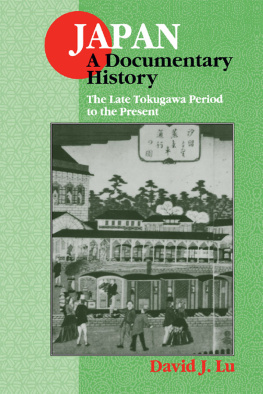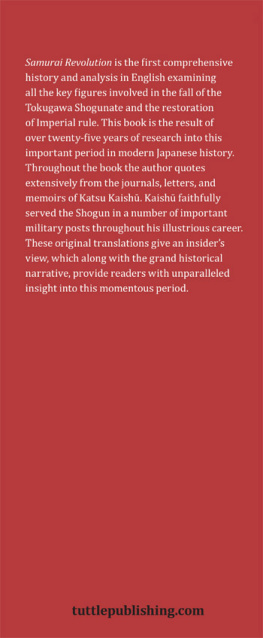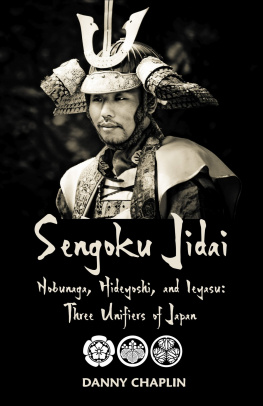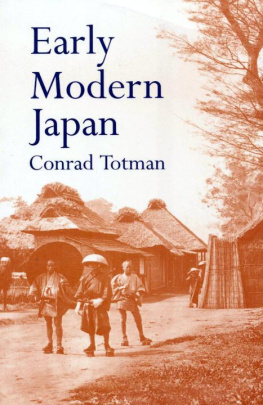Voices of Early Modern Japan
Contemporary Accounts of Daily Life during the Age of the Shoguns
Constantine Nomikos Vaporis

Copyright 2012 by ABC-CLIO, LLC
All rights reserved. No part of this publication may be reproduced, stored in a retrieval system, or transmitted, in any form or by any means, electronic, mechanical, photocopying, recording, or otherwise, except for the inclusion of brief quotations in a review, without prior permission in writing from the publisher.
Library of Congress Cataloging-in-Publication Data
Vaporis, Constantine Nomikos, 1957
Voices of early modern Japan : contemporary accounts of daily life during the age of the shoguns / Constantine Nomikos Vaporis.
p. cm. (Voices of an era)
Includes bibliographical references and index.
ISBN 9780313392009 (hardcopy : alk. paper) ISBN 9780313392016 (ebook)
1. JapanHistoryTokugawa period, 16001868Sources. I. Title.
DS870.V65 2012
952.025dc23 2011042812
ISBN: 9780313392009
EISBN: 9780313392016
16 15 14 13 12 1 2 3 4 5
This book is also available on the World Wide Web as an eBook.
Visit www.abc-clio.com for details.
Greenwood
An Imprint of ABC-CLIO, LLC
ABC-CLIO, LLC
130 Cremona Drive, P.O. Box 1911
Santa Barbara, California 93116-1911
This book is printed on acid-free paper 
Manufactured in the United States of America
Recent Titles in Voices of an Era
Voices of Ancient Egypt: Contemporary Accounts of Daily Life
Rosalie David, editor
Voices of Ancient Greece and Rome: Contemporary Accounts of Daily Life
David Matz, editor
Voices of Early Christianity: Documents from the Origins of Christianity
Kevin W. Kaatz, editor
Voices of Revolutionary America: Contemporary Accounts of Daily Life
Carol Sue Humphrey, editor
Voices of Shakespeares England: Contemporary Accounts of Elizabethan Daily Life
John A. Wagner, editor
Voices of Victorian England: Contemporary Accounts of Daily Life
John A. Wagner, editor
Voices of World War II: Contemporary Accounts of Daily Life
Priscilla Mary Roberts, editor
Voices of Civil War America: Contemporary Accounts of Daily Life
Lawrence A. Kreiser, Jr., and Ray B. Browne, editors
For Martin C. Collcutt and James R. Bartholomew
Contents
Documents of the Shoguns Japan
Preface
Voices of Early Modern Japan: Contemporary Accounts of Daily Life during the Age of the Shoguns contains 60 documents dealing with the Tokugawa period, 16001868. Technically speaking, three documents fall outside the range of these years, but are included because they deal with topics that were either crucial to developments of the Tokugawa yearsalso known as the Edo periodor are important reflections upon that time. Even though neither of the shoguns (Tokugawa) Ieyasu nor Yoshinobu are household names in the United States or Europe, the Tokugawa period and its immediate aftermath, more than any other period in Japanese history, are the subject of great interest, as evidenced by the popularity of the samurai, whether it be in the Tom Cruise film The Last Samurai, in anime (e.g., Samurai Champloo) or in manga (e.g., Vagabond, Rurouni Kenshin). The Tokugawa period, however, is noteworthy for more than just samurai. The Introduction that follows will explain the importance and influence of the period, but much of what foreigners and Japanese alike associate with traditional Japanfor example, sushi, sumo wrestling, woodblock prints, kabuki theater, the tea ceremonywas either developed or achieved broadscale popularity during these years. The continuing interest in, and relevance of, Tokugawa history and culture is immediately evident walking into a bookstore or turning on a television in Japan. The boom in Tokugawa-period culture in publishing has continued unabated since the 1980s, and period-dramas remain a mainstay of Japanese television, as evidenced by Mito Kmon, the long-running (since 1969!), historically based drama that draws from the life of the retired daimyo, Mito Mitsukuni, who travels around the country in the guise of a wealthy merchant, accompanied by two of his samurai retainers (also in disguise).
Primary Documents
Primary documents open a direct window onto the past, as they allow us to listen to the people of a given time speak in their own voices. The document excerpts reproduced in this volume provide the reader with a wide array of perspectives on the people of Tokugawa Japan, their society, government, foreign relations, material and family life, religion and modes of thought, and recreations. From these documents, we can see what kind of society Tokugawa Japans rulers idealized and what the reality of it actually was; we can see how its rulers interacted with, and tried to control, the outside world; we can begin to understand the views and attitudes of the common people as they negotiated their lives around the laws and regulations that the rulers established to order society.
Organization of Sections
The 60 documents are divided into 42 numbered sections, with some sections offering two or three related documents. These sections are divided into seven topical categories, with four sections relating to the domestic sphere, six to material life, six to the political sphere, five to foreign relations, nine to social and economic life, eight to recreational life, and five to religion and morality. It should be noted, however, that these categories are not hard and fast. Some overlap, and in a number of cases, one might argue that a selection could also belong in a different category. For example, while the tea ceremony and archery might, from one perspective, be considered recreation (and hence fall under the category Recreational Life), from another they might also fit in the category Thought, since both involved the pursuit of a way (Japanese, d), a spiritual and/or martial discipline. Similarly, the material in Material Life, one might argue, could also belong in Social and Economic History. Despite this flexibility, the categories chosen represent one way of organizing a vast array of primary source material that the author hopes the reader will find beneficial.
The document selections include a wide variety of typesofficial government laws and regulations, directives sent from one governing body to another, local ordinances, private agreements (contracts), novels, kabuki plays, broadsheets, polemics (sermons, anti-Christian propaganda, and moral instructional readers), letters, and descriptive narratives of everyday life and events, some of which were written by foreign observers. Some of these documents are well known and often excerpted, such as the Laws for the Military Houses issued by the Tokugawa government, or shogunate; the Sword Hunt issued by Toyotomi Hideyoshi in the late sixteenth century, which did much to set the pattern of life during the succeeding centuries; the so-called Closed-Country Edicts of the 1630s that resulted in the expulsion of all Westerners in Japan except the Dutch; and, the idealistic educational tract The Greater Learning for Women, which instructed women on morality and proper behavior. Others are less well known, but offer a variety of different perspectives on Tokugawa life. For example, paired with the document just mentioned, The Greater Learning for Women, are excerpts from the essay Solitary Thoughts, written by a doctors daughter named Tadano Makuzu, who offers a perspective on the relationship between men and women based on observation and actual lived experience. Each of these documents offers the reader a window directly into the age of the shoguns, providing an understanding of the life and times that cannot be had from textbooks or monographs. All documents are presented in translation, in English, with the occasional key Japanese term offered in romanized form, in the Hepburn style, in parentheses. In some cases, the translation has been adapted for the benefit of the modern reader.








